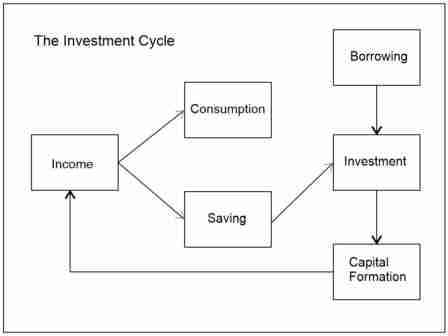Project Financing : A Discussion
Project financing constitute a significant portion of loan investments of banks. Because of large outlays, noteworthy time lag between commitment of funds and generation of cash flows to serve the bank liabilities and irreversibility of the venture, project financing proposals are often subject to a more rigorous analysis and assessment by a team before accepting for investment. Here in this article it has been attempted to unveil some critical and less discussed aspects of project analysis beyond the common framework of market analysis, technical analysis, financial analysis, economic analysis and ecological analysis. This has been divided into five parts. The first part outlines the general concept of projects, second chapter deals with the nature of risks inherent in projects, third part presents some insights from the financing perspectives, fourth part discusses the common weaknesses and potential reasons of project failure and lastly, some conclusive comments have been served.
General Concept
Projects are the recent inventions of management brought about in 1960s. Projects are the packages of work held within more stringent parameters of time, cost and quality. While organizations could run their general operational activities as their routine business work, bigger packages of work requiring more streamlined efforts and planning are taken in the form of projects. Projects of government serve as the building blocks of the development programs and plans of the country. Business organizations formulate projects as investments in long term capital assets and facilities. Such projects are characterized by commitments of huge funds, definite starting and ending dates, clarified limits and scope of work, unique and run with a team formed for their definite purpose. The ideas of project arise from the problems or opportunities faced in business. An organization can encourage and facilitate the generation of project ideas through clear articulation of its objectives, periodic review and analysis of strengths and weaknesses in changing situations and by fostering an environment to honor the ideas brought up by the employees. New project opportunities can be traced into the current performance of existing industries, review of exports and imports, economic and social trends, technological developments, unfulfilled psychological needs and aspirations of consumers, study reports of development agencies and financial institutions, etc. Such project ideas are firstly, subject to preliminary screening against the fundamental criteria like compatibility to the promoters, consistency with the government priorities, availability of inputs, adequacy of market, etc. before they can be formulated as a project.
Nature of Risks in Projects
Risk is a common fact of business life. Projects involve more risks as they involve relatively bigger commitment of funds and the costs and benefits extending into the future that may take unanticipated turns. The risks inherent in projects financing can be viewed from two levels: risks relating to the viability of the project and risks to a bank or financial institution in lending for the project. While projects sponsors are to devote to the assessment of the both levels, banks and financial institutions are more focused towards how the cash-flows may be generated and how they can or cannot sufficiently serve the obligations entailed with the proposed financing. Assessment of the viability of a project requires examination of the projections that run into the future. Being related to the future, risk is natural. While given figures can be analyzed with a number of tools and techniques – Net Present Value (NPV), Internal Rate of Return (IRR), Benefit Cost Ratio (BCR), extracting figures from the blurred future, more so in case of the projects of new and untested businesses is really a difficult task. Techniques like scenario building, decision tree analysis, etc. can be helpful in this.
Projects from Financing Perspectives
From financing perspectives longer maturities are themselves a source of risk. Large scale capital intensive projects usually require substantial investments upfront which generate revenues only in the long term. Project appraisal teams can assess the potential alternatives of situations and can develop scenarios regarding the future; but all subject to some degree of uncertainty. While sensitivity analysis examines the effect of change in one variable upon the total performance of the project, scenario building involves conceiving of different separate scenarios with different assumptions of the costs, revenues, market growth, entry of competitors, development of substitutes, potential twists in the market of raw materials and other key inputs, stances of the government towards the industry, etc. with the probability distributions associated with them. Risks with a project stems from the features of high leverage and non recourse nature of projects. Besides, high profile infrastructure projects also involve political dimensions of risks.
Project Failure: Reasons and Remedies
Projects failures are undesirable. When a project fails, not only the sponsor, beneficiaries but also the
bank in hurt. So the reasons for project failure are to be properly cared of. For this, control accounts may
be set up. Periodic progress reports can be made and presented to review meetings to facilitate comparison to the actual expenditures. Variances can be calculated, judged and remedied in time to
avoid larger discrepancies. The following points may be suggested to bear in mind in project evaluation, financing and management.
- Take care of the right proportion of financing. While under-financing can leave the project unfinished over-financing can impose unnecessary debt burden to the company.
- Avoid accepting suboptimal projects for the additional collateral. Additional collateral cannot compensate to the unsound projects. Projects have to generate cash-flows of their own to serve the bank obligations, additional collateral can just misguide in the assessment of their viability.
- Avoid political influences and pressures to accept projects. Different people, involved with the project in one form or the other, have vested interests on accepting or not accepting the projects for financing. Managers should be careful of not being influenced in judging the projects for financing.
- Be careful in selecting the discount rate. Choice of discount rate in evaluating the project cash
flows should reflect the costs, risks and the profit level desired by the firm. Wrong rates make risky projects appear desirable while safe projects may be discarded. More attention is to be paid in selecting the discount rate when the project is new to the firm. - Do not forget to incorporate the side effects of the project – Taking up a project can have impact on additional borrowing power, change in risk complexion of the firm, product cannibalization, etc.
- Project expansion, curtail or abandonment options to be evaluated: Projects are generally taken up in a view of running across its full life. However, a number of options are available with them and firms need not necessarily be evaluated based just on the straight course of analysis, investments on projects can be made phase-wise examining the results with the initial investments. Sometimes they may turn appropriate of divesting (selling off to an outside party) or abandon before the economic life assumed in the beginning. Such options constitute a significant aspect of analysis which is generally not cared of.
Conclusion
After the termination decade-long conflict and violence, Nepalese entrepreneurs are likely to come up with ambitious projects and proposals with banks. There is undoubtedly, a real need to unleash the potentials of development and reconstruction in the post conflict phase of the country. Projects are to form the building blocks of development. Projects consistent to the national priorities are not merely the businesses of the sponsors but a part of the grand project of nation building. Bank finance is virtually the essential component in such ventures. Against this backdrop, project appraisal systems of banks and financial institutions are to be more refined, rational and conscious to cash the entrepreneurial tendencies and potentialities in the country. One or few projects turning into failure can retard the development activities and at the same time, hurt the instinct of the aspiring.




